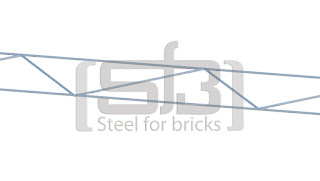The reinforcement does not improve at all by the fact the wire is corrugated. The conditions for grip relating to transferring forces evenly through-out small-diameter bars, such as the type of masonry reinforcement depend more on the measure of mortar and not the masonry reinforcement.
Grip provided by corrugated bars is only needed when the forces you may have are very large, this only occurs within very thick bars. In the case of the reinforcement a number is worth a thousand words, two bars of 4mm in diameter can transfer securely 10kN, following the required regulations.
This value has been tested on smooth bars of reinforcement. Furthermore the calculation shows the real value of the force that is transferred across the reinforcement (that is met by the minimum quantity requirements) in worst case scenarios, is approximately half.
Consequently the corrugated reinforcement makes no extra benefits of reinforcement that weren’t in the traditional reinforcement. It is important that the technique of reinforced concrete, capable of transferring large forces, use normal plain bars when there is a small diameter. What really improves the transmission of forces is the existence of a suitable cover of reinforcement in the overlap areas.
















